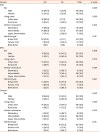1. Kliegman RM, Nelson WE. Nelson textbook of pediatrics. 20th ed. Philadelphia (PA): Elsevier;2016.
2. Black RE. Patterns of Growth in Early Childhood and Infectious Disease and Nutritional Determinants. In : Black RE, Makrides M, Ong KK, editors. Complementary Feeding: Building the Foundations for a Healthy Life. Basel: Karger Publishers;2017. p. 63–72.
4. Andrade FB, Gomes TA, Elias WP. A sensitive and specific molecular tool for detection of both typical and atypical enteroaggregative
Escherichia coli
. J Microbiol Methods. 2014; 106:16–18.


5. Black RE, Morris SS, Bryce J. Where and why are 10 million children dying every year? Lancet. 2003; 361:2226–2234.


6. Mitra H, Shokoufeh A, Homa B, Azam M. The effect of oral zinc sulfate on hepatitis b vaccine immunogenicity in premature infants. Life Sci J. 2012; 9:3359–3361.
8. Soofi S, Cousens S, Iqbal SP, Akhund T, Khan J, Ahmed I, et al. Effect of provision of daily zinc and iron with several micronutrients on growth and morbidity among young children in Pakistan: a cluster-randomised trial. Lancet. 2013; 382:29–40.


10. Berni Canani R, Buccigrossi V, Passariello A. Mechanisms of action of zinc in acute diarrhea. Curr Opin Gastroenterol. 2011; 27:8–12.

11. Kechagia M, Basoulis D, Konstantopoulou S, Dimitriadi D, Gyftopoulou K, Skarmoutsou N, et al. Health benefits of probiotics: a review. ISRN Nutr. 2013; 2013:481651.

12. Gibson GR, Hutkins R, Sanders ME, Prescott SL, Reimer RA, Salminen SJ, et al. Expert consensus document: the International Scientific Association for Probiotics and Prebiotics (ISAPP) consensus statement on the definition and scope of prebiotics. Nat Rev Gastroenterol Hepatol. 2017; 14:491–502.


13. Gill H, Prasad J. Probiotics, Immunomodulation, and Health Benefits. In : Bösze Z, editor. Bioactive Components of Milk. New York (NY): Springer;2008. p. 423–454.
14. Abraham AA, Amritha SR, Selvin CD. A comparative evaluation on the effect of zinc-probiotic and probiotic therapy in paediatric acute diarrhoea and the impact of counselling of mothers. Int J Pharm Pharm Sci. 2016; 8:241–243.
15. Brooks WA, Santosham M, Roy SK, Faruque AS, Wahed MA, Nahar K, et al. Efficacy of zinc in young infants with acute watery diarrhea. Am J Clin Nutr. 2005; 82:605–610.


16. Sachdev HP, Mittal NK, Mittal SK, Yadav HS. A controlled trial on utility of oral zinc supplementation in acute dehydrating diarrhea in infants. J Pediatr Gastroenterol Nutr. 1988; 7:877–881.


18. Bhatnagar S, Bahl R, Sharma PK, Kumar GT, Saxena SK, Bhan MK. Zinc with oral rehydration therapy reduces stool output and duration of diarrhea in hospitalized children: a randomized controlled trial. J Pediatr Gastroenterol Nutr. 2004; 38:34–40.

19. Bhandari N, Bahl R, Taneja S, Strand T, Mølbak K, Ulvik RJ, et al. Substantial reduction in severe diarrheal morbidity by daily zinc supplementation in young north Indian children. Pediatrics. 2002; 109:e86.

20. Boran P, Tokuc G, Vagas E, Oktem S, Gokduman MK. Impact of zinc supplementation in children with acute diarrhoea in Turkey. Arch Dis Child. 2006; 91:296–299.


21. Torabi SZ, Abbaszadeh A, Ahmadiafshar A. The effect of oral zinc sulfate on the management of acute gastroenteritis in children. ZUMS J. 2011; 19:58–65.
23. Freedman SB, Sherman PM, Willan A, Johnson D, Gouin S, Schuh S, et al. Emergency department treatment of children with diarrhea who attend day care: a randomized multidose trial of a
Lactobacillus helveticus and
Lactobacillus rhamnosus combination probiotic. Clin Pediatr (Phila). 2015; 54:1158–1166.


24. Goldenberg JZ, Ma SS, Saxton JD, Martzen MR, Vandvik PO, Thorlund K, et al. Probiotics for the prevention of
Clostridium difficile-associated diarrhea in adults and children. Cochrane Database Syst Rev. 2013; CD006095.

25. Takagi A, Yanagi H, Ozawa H, Uemura N, Nakajima S, Inoue K, et al. Effects of Lactobacillus gasseri OLL2716 on Helicobacter pylori-associated dyspepsia: a multicenter randomized double-blind controlled trial. Gastroenterol Res Pract. 2016; 2016:7490452.
26. Brown AC, Valiere A. Probiotics and medical nutrition therapy. Nutr Clin care. 2004; 7:56.


27. Dinleyici EC, Vandenplas Y. PROBAGE Study Group.
Lactobacillus reuteri DSM 17938 effectively reduces the duration of acute diarrhoea in hospitalised children. Acta Paediatr. 2014; 103:e300–e305.
28. Szajewska H, Mrukowicz JZ. Probiotics in the treatment and prevention of acute infectious diarrhea in infants and children: a systematic review of published randomized, double-blind, placebo-controlled trials. J Pediatr Gastroenterol Nutr. 2001; 33:Suppl 2. S17–S25.

29. Thibault H, Aubert-Jacquin C, Goulet O. Effects of long-term consumption of a fermented infant formula (with
Bifidobacterium breve c50 and
Streptococcus thermophilus 065) on acute diarrhea in healthy infants. J Pediatr Gastroenterol Nutr. 2004; 39:147–152.


30. Cimperman L, Bayless G, Best K, Diligente A, Mordarski B, Oster M, et al. A randomized, double-blind, placebo-controlled pilot study of
Lactobacillus reuteri ATCC 55730 for the prevention of antibiotic-associated diarrhea in hospitalized adults. J Clin Gastroenterol. 2011; 45:785–789.


31. Riddle DJ, Dubberke ER.
Clostridium difficile infection in the intensive care unit. Infect Dis Clin North Am. 2009; 23:727–743.
32. Laxminarayan R, Duse A, Wattal C, Zaidi AK, Wertheim HF, Sumpradit N, et al. Antibiotic resistance-the need for global solutions. Lancet Infect Dis. 2013; 13:1057–1098.









 PDF
PDF ePub
ePub Citation
Citation Print
Print


 XML Download
XML Download